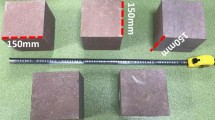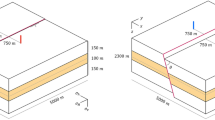Abstract
Identification of the meta-instable stress state and study of its mechanism and evolution of relevant physical fields would be of great significance for determination of potential seismic risks and estimation of critical times. In laboratory experiments, that the specimen enters the meta-instable is marked by accelerated stress release. Could we use the experimental result to identify the earthquake in natural conditions? Because the observational data from one station can only reflect the stress state beneath this station, the key problem for identification of the meta-instability is how to recognize regional stress state through observational data from many stations. In this work, we choose the evolution of the temperature field over varied deformation stages during a stick-slip event on a 5° bending fault as an example, and attempt to find the response features of the physical quantity when the fault enters the meta-instable state. We discuss the characteristics of stages for the stress build-up, stress-time process deviating from linearity before instability, meta-instability, instability, and post-instability, respectively. The result shows that the fault instability slide is a conversion process from independent activities of each fault segment to synergism activity. The instability implies completion of the synergism. The stage deviating from linearity is the onset of stress release, and it is also the onset of the synergism. At the meta-instability stages, stress release becomes dominant, while the synergism tends to finish. Therefore, the analysis of the regional overall stress state should not start from individual stations, and instead it should begin with the evolution of the whole deformation field.
Similar content being viewed by others
References
Ma Z J, Fu Z X, Zhang Y Z, et al. Nine Great Earthquakes in China Mainland During 1966–1976. Beijing: Seismological Press, 1982. 216
Zhu F M, Wu G. The 1975 Haicheng Earthquake. Beijing: Seismological Press, 1982
Compilation Group for the 1976 Tangshan Earthquake, State Seismological Bureau. The 1976 Tangshan Earthquake. Beijing: Seismological Press, 1982. 459
Guo Z J, Ma Z J, ed. Research of Great Earthquakes in China. Beijing: Seismological Press, 1988
Department of Prediction and Prevention, China Earthquake Administration. Methods and Theories for Continental Earthquakes—Advances in Earthquake Prediction Research During the Eighth Five-Year Plan of China. Beijing: Seismological Press, 1998. 704
Mei S R, Feng D Y, Zhang G M, et al. Introduction to Earthquake Prediction in China. Beijing: Seismological Press, 1993
Sun Q Z, Wu S G, ed. Development of Earthquake Monitoring and Prediction in China during 1966–2006 (Volume 1 and 2 ). Beijing: Seismological Press, 2007. 452
Zhang G M, Fu Z X, Gui X T, et al. Introduction to Earthquake Prediction. Beijing: Science Press, 2001
Research Group of “Researches on Earthquake Risk Regions and Losses Prediction of China Continent During from 2006 to 2020”. Researches on Earthquake Risk Regions and Losses Prediction of China Continent During from 2006 to 2020. Beijing: Seismological Press, 2007
Zhang Z C, Zheng D L, Luo Y S, et al. A preliminary study of precursor data in “Earthquake Cases of China” (in Chinese). Earthquake, 1990, 10: 9–24
Zhang Z C, ed. Earthquake Cases of China—1966–1975. Beijing: Seismological Press, 1988. 222
Zhang Z C, ed. Earthquake Cases of China—1976–1980. Beijing: Seismological Press, 1990. 263
Zhang Z C, ed. Earthquake Cases of China—1981–1985. Beijing: Seismological Press, 1990. 294
Zhang Z C, ed. Earthquake Cases of China—1986–1988. Beijing: Seismological Press, 1999. 394
Zhang Z C, ed. Earthquake Cases of China—1989–1991. Beijing: Seismological Press, 2000. 453
Zhang Z C, ed. Earthquake Cases of China—1992–1994. Beijing: Seismological Press, 2002. 429
Chen Q F, ed. Earthquake Cases of China—1995–1996. Beijing: Seismological Press, 2002. 489
Chen Q F, ed. Earthquake Cases of China—1997–1999. Beijing: Seismological Press, 2003. 468
Din J H, Yu S R, Xiao W J. Exploration to seismic precursors and impeding and short-term earthquake prediction (in Chinese). Earthquake, 2003, 23: 43–50
Department of Monitoring and Prediction, China Earthquake Administration. The 1998 Zhangbei Earthquake. Beijing: Seismological Press, 1999. 244
Chen R. Consistency of focal mechanism solutions as a new parameter for description of seismicity (in Chinese). Chin J Geophys, 1980, 2: 39–47
Chen R. Dimension decrease during failure of rock (in Chinese). Chin J Geophys, 1989, 32(Suppl): 39–47
Diao G L, Zhao Y P. Consistency feature of focal mechanism solutions before major aftershocks long after the Datong earthquake (in Chinese). Inland Earthq, 2004, 18: 202–206
Wyss M, Sammis C G, Nadeau R M, et al. Fractal dimension and b value on creeping and locked patches of the San Andreas fault near Parkfield, California. Bull Seismol Soc Am, 2004, 94: 410–421
Yang W Z, D Vere Jones, Ma L, et al. A method for locating the critical region of a future earthquake using the critical earthquake concept (in Chinese). Earthquake, 2000, 20: 28–37
Yang W Z, Ma L. Seismicity acceleration on model and its application to several earthquake region in China. Acta Seismol Sin, 1999, 21: 32–41
Jiang C S, Wu Z. L Accelarating Moment release (AMR) before strong earthquakes: A retrospective case studyof a controversial precursor (in Chinese). Chin J Geophys, 2009, 52: 691–702
Ohnaka M. Earthquake source nucleation: A physical model for short-term precursors. Tectonophysics, 1992, 211: 149–178
Ребецкий Ю.Л. Оценка величин напряжений в методе катакла стического аналиэа разрывов. ДАН РАН. 2009, 428: 397–402
Ребецкий Ю.Л. Современные проблемы тектонофизики. Физика Земли, 2009, 11: 3–7
Ребецкий Ю.Л. Напряженное состояние земной коры Курил и Камчатки перед Симущирскими землетрясениями. Тихоокеанская геология, 2009, 3: 477–490
Sherman S I, Demyanovich V M, Lysak S V. Active faults, seismicity and recent fracturing in the lithosphere of the Baikal rift system. Tectonophysics, 2004, 380: 261–272
Sherman S I. A tectonophysical model of a seismic zone: Experience of development based on the example of the Baikal Rift System. Izvestiya Phys Solid Earth, 2009, 45: 938–951
Sherman S I, Gorbunova E A. New data on the regularities of the earthquake manifestation in the Baikal Seismic Zone and their forecast. Doklady Earth Sci, 2010, 435: 1659–1664
Bornyakov S A, Truskov V A, Cheremnykh A V. Dissipative structures in fault zones and their diagnostic criteria (from physical modeling data). Russian Geol Geophys, 2008, 49: 1–6
Борняков С А. Деформационные предвстники устщ Баргузинского землетрясения 20 Мая 2008 г. ДАН РАН, 2010, 431: 1–3
Brace W F, Byerlee J D. Stick-slip as a mechanism for earthquakes. Science, 1966, 153: 990–992
Byerlee J D. Frictional characteristics of granite under high confining pressure. J Geophys Res, 1967, 72: 3639–3648
Ma J, Ma S L, Liu L Q, et al. Physical Field evolution and instability properties of fault geometry (in Chinese). Acta Seism Sin, 1996, 18: 200–207
Deng Z H, Ma S L, Ma J, et al. Experimental study on stick-slip instability and evolution of its physical field (in Chinese). Seismol Geol, 1995, 17: 306–310
Ma S L, He C R. Period doubling as a result of slip complexities in sliding surfaces with strength heterogeneity. Tectonophysics, 2001, 337: 135–145
Ma S L, Ma J, Liu L Q. Experimental evidence for seismic nucleation phase. Chin Sci Bull, 2002, 47: 769–773
Ma S L, Liu L Q, Ma J, et al. Experimental study on nucleation process of stick-slip instability on homogeneous and non-homogeneous faults. Sci China-Earth Sci, 2003, 46(Suppl): 56–66
Liu L Q, Liu T C. Design and trial-manufacture of the system for measuring physical fields of tectonic deformation in laboratory (in Chinese). Seismol Geol, 1995, 17: 357–362
Liu L Q, Ma J, Ma S L. Characteristics and evolution of background strain field on typical structuremodels (in Chinese). Seismol Geol, 1995, 17: 349–356
King G C P, John J F N. Role of fault bends in the initiation and termination of earthquake rupture. Science, 1985, 228: 984–987
Andrews D J. Mechanics of fault junctions. J Geophys Res, 1989, 94: 9389–9397
Andrews D J. Fault geometry and earthquake mechanics. Annali Di Geofisica, 1994, X VII: 1342–1348
Ma J, Ma W T, Ma S L, et al. Experimental study and numenrical simulation on physical fields during deformation of a 5° bend fault (in Chinese). Seismol Geol, 1995, 17: 318–326
Aydin A, Du Y J. Surface rupture at a fault bend: the 28 June 1992 Landers, California earthquake. Bull Seismol Soc Am, 1995, 85: 111–128
Kase Y, Day S M. Spontaneous rupture processes on a bending fault. Geophys Res Lett, 2006, 33: L10302
Hemendra K A. Influence of fault bends on ruptures. Bull Seismol Soc Am, 1997, 87: 1691–1696
Kato N, Satoh T, Lei X L, et al. Effect of fault bend on the rupture propagation process of stick-slip. Tectonophysics, 1999, 310: 81–99
Poliakov A N B, Dmowska R, Rice J R. Dynamic shear rupture interactions with fault bends and off-axis secondary faulting. J Geophys Res, 2002, 107: 1–17
Liu P X, Liu L Q, Chen S Y, et al. An experiment on the infrared radiation of surficial rocks during deformation (in Chinese). Seismol Geol, 2004, 26: 502–511
Liu P X, Ma J, Liu L Q, et al. An experimental study on variation of thermal fields during the deformation of a compressive en echelon fault set (in Chinese). Prog Nat Sci, 2007, 17: 454–459
Chen S Y, Ma J, Liu P X, et al. A preliminary study on correlation between thermal infrared radiation of land surface and borehole strain (in Chinese). Prog Nat Sci, 2008, 18: 145–153
Ma J, Ma S P, Liu L Q, et al. Experimental study of thermal and strain fields during deformation of en enchelon faults and its geological implications. Geodyn Tectonophys, 2010, 30: 24–35
Chen S Y, Liu L Q, Liu P X, et al. Theoretical and experimental study on relationship between strees-strain and temperature variation. Sci China Ser D-Earth Sci, 2009, 52: 1825–1834
Guo Y S, Ma J, Yun L, et al. The experimental study on stick-slip process of bending faults. Geodyn Tectonophys, 2011, 2: 35–44
Yun L, Guo Y S, Ma J. An experimental study of evolution of physical field and the alternative activities during stick-slip of 5° bend fault (in Chinese). Seismol Geol, 2011, 33: 356–368
Author information
Authors and Affiliations
Corresponding author
Rights and permissions
About this article
Cite this article
Jin, M.A., Sherman, S.I. & Guo, Y. Identification of meta-instable stress state based on experimental study of evolution of the temperature field during stick-slip instability on a 5° bending fault. Sci. China Earth Sci. 55, 869–881 (2012). https://doi.org/10.1007/s11430-012-4423-2
Received:
Accepted:
Published:
Issue Date:
DOI: https://doi.org/10.1007/s11430-012-4423-2




